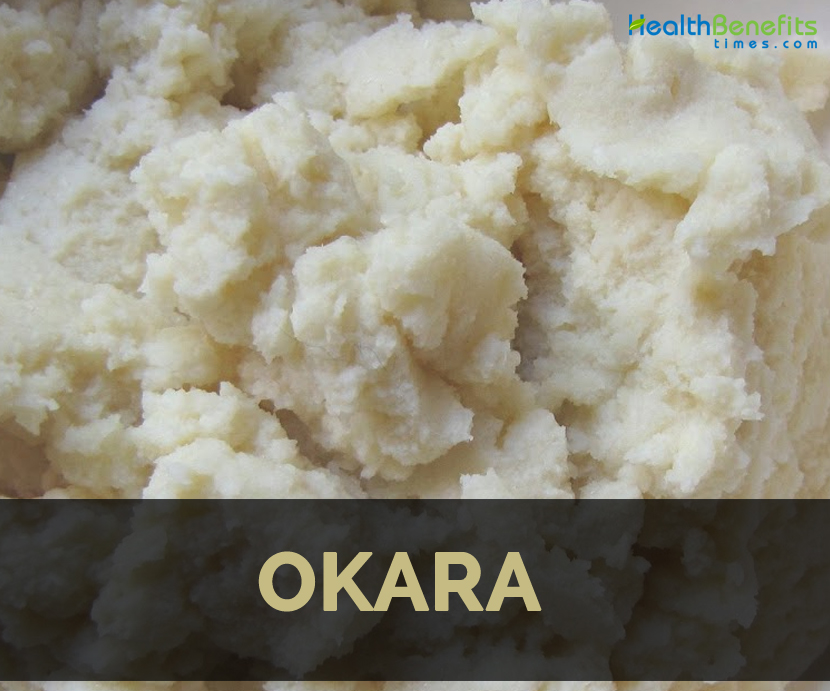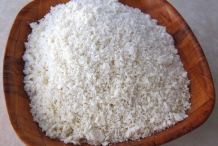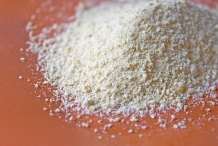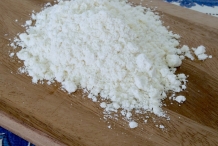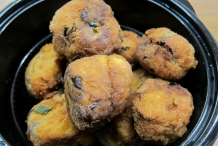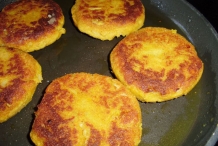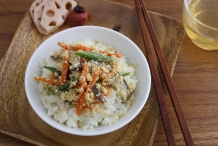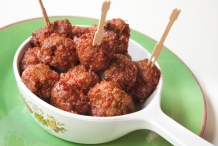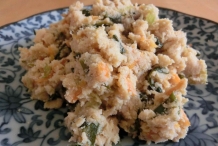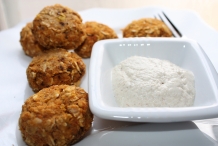Open-faced okara and tuna salad sandwich
Ingredients:
- 200 g can of tuna packed in water
- 1/2 cup soft Okara
- 4-5 tbsp mayonnaise
- 1 Tbsp. lemon juice
- 1 Tbsp. Dijon style mustard
- Few grinds of black pepper
- 1/2 tsp salt
- Dash of sweet paprika
- 2 Tbsp. green onion (Finely chopped)
- 6 slices of toast
- Lettuce leaves
Directions:
Mix soft okara, mustard, drained and mashed up tuna, lemon juice, mayonnaise, salt, pepper and 1 tbso. of green onion till it becomes smooth. Place the leaves of lettuce on the toast, a pile tablespoon of tuna-okara mixture on top. Sprinkle each with remaining green onion and little paprika.
Unohana – Sauteed Okara with Vegetables
Ingredients:
- 150 g fresh okara
- 4 dried shiitake mushrooms
- 1/2 a medium onion
- 50 g konyaku
- 1/2 a small carrot
- 3 tbsp. sugar
- 1 tbsp. mirin
- 3 tbsp. soy sauce
- 1/2 tsp. dashi powder
- 300 ml of water used to soak dried shiitake mushrooms
- Green shallots
- 1 tbsp. olive oil
Instructions:
- Soak dried shiitake mushrooms for about 3 to 4 hours or place it in a bowl with water and microwave for 30 seconds.
- Chop mushrooms, carrot, onion, shallots and konyaku finely.
- Heat olive oil in a frying pan and cook onion till it becomes translucent.
- Add chopped vegetables besides shallots. Cook with the onion.
- Add Okara and cook till it becomes crumbly.
- Add water used to soak mushrooms and all soy sauce, sugar, etc.
- Keep stirring everything together over low heat until the liquid evaporates.
- Add shallots. Cook slightly and then turn off the heat.
Okara Salad
Ingredients:
- 100 g okara
- 3 cm piece carrot
- 8 cm piece cucumber
- 2 tbsp. boiled corn
- 2 to 3 tbsp. Onion dressing
- 2 slices ham
- 3 to 4 tbsp. mayonnaise
- 1 tsp. soy sauce
- Salt and pepper for seasoning
Method:
- Slice thinly cucumber, sprinkle salt on it and leave it for 5 minutes. Wash it with water. Drain well.
- Cut carrot into bite sized pieces and boil lightly.
- Cut ham into squares.
- Mix all ingredients in a bowl. Season to taste.
Okara Curry
Ingredients:
- 2 tablespoons oil
- 1 tablespoon chopped onion
- 1 sprig fresh curry leaves
- 1 clove garlic (Minced)
- 1 teaspoon chili powder
- 1-inch piece stick cinnamon
- Teaspoon turmeric
- 1 teaspoon curry powder
- 1 teaspoon salt
- 1 ripe tomato (Chopped)
- 1 green chili pepper (Chopped)
- Boiling water
- Blanched and cooked Okara
Directions:
- In a saucepan, heat oil and fry curry leaves, garlic, onion, chili powder, cinnamon, curry powder, salt, turmeric and green chili pepper.
- Stir well by add the chopped tomato.
- Then add Okara and mix well.
- Stir in water. Let mixture to a simmer for 5 minutes. If needed add more water to obtain the desired consistency.
- Serve curry hot with rice, pasta, bread or any cooked grain.
Okara-Miso Soup
Ingredients:
- ¼ cup carrot (Sliced into thin strips)
- 1 tablespoon miso
- 1 teaspoon Japanese seven spice chili powder
- 1 piece onion (Halved, chopped)
- 1 cup Okara
- 2 tablespoons sesame oil
- ¼ cup Parsnips (Sliced into thin strips)
- 3 cups soy milk or water
Directions:
- Set a pot in a medium heat. Pour sesame oil and allow it to heat up.
- Sauté onions then add carrots and parsnips. Cook it for two minutes.
- Pour in soy milk or water and bring to a boil.
- Reduce heat and make the vegetables simmer.
- Add Okara. Place in miso and dissolve completely in soup.
- Simmer it for about two or more minutes.
- Sprinkle it with Japanese seven-spice chili powder.
How to Eat
- When consumed on its own it is flavorless.
- It could be used in porridges and stews such as Korean biji-jjigae.
- It is added to baked goods such as cookies, breads and muffins.
- It is used in unohana, a side dish in Japan which comprises of okara cooked with sliced carrots, mirin, soy sauce, shiitake mushrooms and burdock root.
- It is used for making tempeh.
- In Eastern China, Okara is consumed in Shandong cuisine by steaming wet mixture of Okara which have been formed into blocks.
- It is also used as an ingredient in vegetarian burger patties.
- It is used to provide body to croquettes, soups and casseroles.
- Okara could be combined into bread, pasta sauce or soy burgers.
- It is used as a substitute for eggs to provide moisture to baked products.
References:
https://en.wikipedia.org/wiki/Okara_(food)
http://justhungry.com/2006/04/milking_the_soy.html
https://www.chopstickchronicles.com/unohana-sauteed-okara-vegetables/
http://www.tandfonline.com/doi/abs/10.1080/87559129.2011.595023
https://cookpad.com/us/recipes/279961-okara-salad
http://www.ellenskitchen.com/clearlight/okara/okara.html
https://hubpages.com/health/Okara-Japanese-Food-for-Healthy-Diet-and-Weight-Loss
Comments
| Okara Quick Facts | |
|---|---|
| Name: | Okara |
| Taste | Neutral |
| Calories | 93 Kcal./cup |
| Major nutrients | Copper (27.11%) Selenium (23.45%) Manganese (21.43%) Iron (19.88%) Tryptophan (13.86%) |
| Name | Okara |
|---|---|
| Common/English Name | Soy pulp, tofu dregs |
| Name in Other Languages | Chinese: dòuzhā, dòufuzhā;p Japanese: okara; Korean: biji, kongbiji |
| Color | White or yellowish |
| Flavor | Neutral |
| Major Nutritions | Copper, Cu 0.244 mg (27.11%) Selenium, Se 12.9 µg (23.45%) Manganese, Mn 0.493 mg (21.43%) Iron, Fe 1.59 mg (19.88%) Tryptophan 0.061 g (13.86%) Isoleucine 0.194 g (11.60%) Carbohydrate 14.92 g (11.48%) Vitamin B6 (Pyridoxine) 0.14 mg (10.77%) Phosphorus, P 73 mg (10.43%) Calcium, Ca 98 mg (9.80%) |
| Calories in 1 cup (122 gm) | 93 Kcal. |


